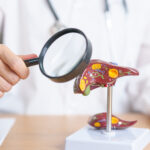
HIV (human immunodeficiency virus) is a virus that attacks cells of the immune system. When left untreated, it leads to an immunodeficiency syndrome called AIDS (acquired immunodeficiency syndrome).
HIV targets and kills the CD4 cells of the immune system. These cells fight off pathogens such as bacteria and viruses. The destruction of CD4 cells by HIV has broad impacts on an individual’s immunity. People with HIV infection can be more prone to getting other infections (called opportunistic infections). They can have more severe symptoms from common infections and stay sick longer.
Over time, typically in 8-10 years, the CD4 count can reduce from a normal range of 500-1500 CD4 cells/mm^3 to about 200 CD4 cells/mm^3. Even when the CD4 cell counts are within normal range, the individual may start getting too many opportunistic infections. At this stage, the HIV infection is said to have progressed to AIDS. People typically live for about 3 years after getting AIDS. New virus suppression drugs can inactivate the virus, and stop the HIV infection from progressing to AIDS.
Modes of HIV transmission
Someone who has HIV infection or AIDS can transmit the virus to others by the following channels:
- Transmission by blood. Coming in contact with the blood of an infected person by sharing needles, or through mixing of blood through open cuts, wounds, or sores.
- Transmission by semen, pre-ejaculatory fluid, vaginal fluids, or rectal fluids. These body fluids of an infected person contain HIV. HIV can be transmitted if the virus in these fluids comes in contact with someone’s mucous membranes found inside the vagina, the mouth, or the rectum. The infection can also occur if the fluids come in contact with broken skin, such as open cuts or sores.
- Perinatal transmission. An infant can contract HIV as a fetus in the womb of an infected mother, or during birth.
- Transmission by breastmilk. Breast milk of an infected mother also contains HIV, which can transmit HIV to the infant. Donated unpasteurized breast milk positive for HIV can be a source of infection in infants.
HIV is not transmitted by:
- Insect bites such as those from mosquitoes and ticks
- Saliva or nasal fluids through coughing or sneezing
- Physical touch that does not involve the exchange of body fluids, such as hugging, shaking hands, and social kissing with a closed mouth
- Sharing drinking glasses, utensils, and toilets
Who is at risk of getting HIV?
Anyone can get HIV by having unprotected anal, oral, or vaginal sex with someone who is HIV-positive. The subgroups more at risk are individuals who have multiple or new sex partners, gay, bisexual, and other men who have sex with men, and those who share needles and syringes. Some other STIs such as chlamydia, gonorrhea, and herpes can also increase a person’s risk of getting HIV.

Treatment options and disease management
HIV is not curable. The body can never destroy the virus and there is no treatment that can remove it from someone’s body once they have it. However, people with HIV can still live healthy lives by managing their viral load by getting HIV treatment, which consists of antiretroviral therapy (ART).
ART prevents the virus from replicating in the body and reduces the viral load. The treatment should be started as soon as HIV infection is confirmed to prevent damage to the immune system. It takes about 6 months to show a substantial reduction in the viral load. Once the viral load is undetectable and stays so for another six months, and the patients keep taking their medication regularly, they will not sexually transmit the virus to their HIV-negative partners.
Pregnant persons who stay on ART throughout their pregnancy, give the prescribed preventative medication to their infant after birth, and do not breastfeed have less than a 1% chance of transmitting HIV to their infants.
ART only reduces the viral load as long as the patient takes their medication regularly as prescribed. Stopping treatment or missing doses results in the viral load rebounding. Due to the widespread use of ART, the HIV infection of most HIV-positive individuals in the U.S. does not progress to AIDS.
Persisting challenges with HIV treatment
ART has saved millions of lives and offered an effective way to control a deadly virus. However, the therapy cannot completely remove the virus or its effects from the body.
Over 30 years of its use, scientists have noticed that even the completely suppressed virus can continue to stimulate the immune system. Individuals on ART still have increased secretion of a number of cytokines in their blood, which are chemicals that control the activity of the immune system. This constant stimulation of the immune system was correlated to earlier than normal appearance of age-related maladies such as kidney disease, and cardiovascular or neurological problems.
Prevention
You can prevent getting HIV infection by:
- Abstaining from sexual activity
- Wearing condoms and dental dams correctly during anal, oral, and vaginal sex
- Not sharing needles or syringes
- When acquiring breast milk for your baby, only obtaining pasteurized donor milk from trusted facilities where the milk is tested for pathogens including HIV
In addition, there are additional treatments that can be used to prevent getting HIV.
These include:
- Pre-exposure prophylaxis (PrEP). This treatment can protect people who are at risk of getting HIV due to having an HIV-positive partner, or due to sexual preferences or drug use habits.
- Post-exposure prophylaxis (PEP). This medication when taken within 72 hours of possible HIV exposure can prevent the virus from taking hold.
Testing
Regular testing can prevent the spread of HIV and alert you to an HIV infection early. The earlier ART is started, the lesser the damage the virus does to your immune system. Most HIV tests can be accessed confidentially for free or at a low cost through the CDC.
Find a testing location near you using the CDC’s website at https://gettested.cdc.gov/ or call 1-800-CDC-INFO (1-800-232-4636).
The information provided in our blog posts is for informational purposes only and is not intended as a substitute for professional medical advice, diagnosis, or treatment. Always seek the advice of your physician or other qualified health provider with any questions you may have regarding a medical condition. Never disregard professional medical advice or delay in seeking it because of something you have read on this blog.






